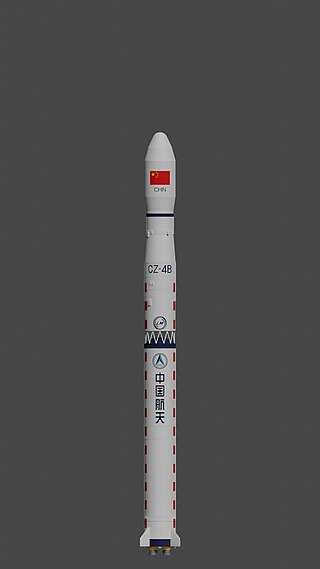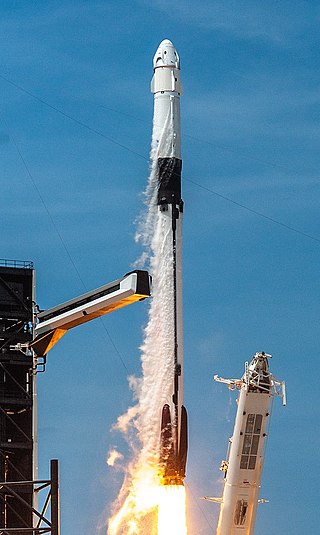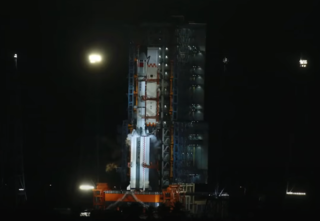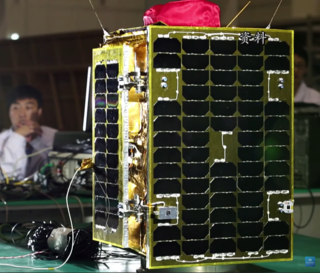
Ariane 5 is a retired European heavy-lift space launch vehicle developed and operated by Arianespace for the European Space Agency (ESA). It was launched from the Centre Spatial Guyanais (CSG) in French Guiana. It was used to deliver payloads into geostationary transfer orbit (GTO), low Earth orbit (LEO) or further into space. The launch vehicle had a streak of 82 consecutive successful launches between 9 April 2003 and 12 December 2017. Since 2014, Ariane 6, a direct successor system, is in development.

The Long March 2C (LM-2C), also known as the Chang Zheng 2C (CZ-2C), is a Chinese orbital launch vehicle, part of the Long March 2 rocket family. Developed and manufactured by the China Academy of Launch Vehicle Technology (CALT), the Long March 2C made its first launch on 9 September 1982. It is a two-stage launch vehicle with storable propellants, consisting of Nitrogen Tetroxide and Unsymmetrical Dimethylhydrazine. The launch vehicle was derived from the DF-5 ICBM.

This article outlines notable events occurring in 2005 in spaceflight, including major launches and EVAs. 2005 saw Iran launch its first satellite.

1971 saw the last three known deaths of cosmonauts of the Soviet space program and the only deaths in space. Their mission was to man humanity's first space station. The experimental bay door failed to separate so the first crew failed to dock and second crew were killed on re-entry. 1971 also saw the launch of the first and only British satellite on top of a British rocket after that success the program was cancelled.

The Soyuz-FG launch vehicle was an improved version of the Soyuz-U from the R-7 family of rockets, designed and constructed by TsSKB-Progress in Samara, Russia. Guidance, navigation, and control system was developed and manufactured by "Polisvit" Special Design Bureau.

The Long March 4B, also known as the Chang Zheng 4B, CZ-4B, and LM-4B, is a Chinese expendable orbital launch vehicle. Launched from Launch Complex 1 at the Taiyuan Satellite Launch Center, it is a 3-stage launch vehicle, used mostly to place satellites into low Earth orbit and Sun-synchronous orbits. It was first launched on 10 May 1999, with the FY-1C weather satellite, which would later be the target in the 2007 Chinese anti-satellite missile test.
ChinaSat is the brand name of communications satellites operated by China Satellite Communications.

This article lists all active and upcoming orbital launch systems. For retired launch vehicles, see Comparison of retired orbital launch systems.
The Feng Bao 1, also known as FB-1, was a Chinese carrier rocket launched between 1972 and 1981. It was replaced by the nearly identical Long March 2, which had been developed at the same time for political reasons related to China's Cultural Revolution.

Yaogan is the cover name used by the People's Republic of China to refer to its military reconnaissance satellites. Yaogan satellites are largely known to primarily support the People's Liberation Army's Strategic Support Force (PLASSF), formerly the Aerospace Reconnaissance Bureau of the Second Department of the General Staff. The Yaogan program is the successor to the Fanhui Shi Weixing (FSW) recoverable reconnaissance satellite program but, unlike its predecessor, includes a variety of classes utilizing various means of remote sensing such as optical reconnaissance, synthetic-aperture radar (SAR), and electronic intelligence (ELINT) for maritime surveillance. Yaogan satellites have been launched from the Taiyuan Satellite Launch Center (TSLC) in Shanxi province, the Jiuquan Satellite Launch Center (JSLC) in Inner Mongolia, Xichang Satellite Launch Center (XSLC) in Sichuan province and the Wenchang Space Launch Site (WSLS) in Hainan province.

This article documents notable spaceflight events during the year 2019.

Notable spaceflight activities in 2017 included the maiden orbital flight of India's Geosynchronous Satellite Launch Vehicle Mark III on 5 June and the first suborbital test of Rocket Lab's Electron rocket, inaugurating the Mahia spaceport in New Zealand. The rocket is named for its innovative Rutherford engine which feeds propellants via battery-powered electric motors instead of the usual gas generator and turbopumps.

This article documents notable spaceflight events during the year 2018. For the first time since 1990, more than 100 orbital launches were performed globally.

A small-lift launch vehicle is a rocket orbital launch vehicle that is capable of lifting 2,000 kg (4,400 lb) or less or under 5,000 kilograms (11,000 lb) of payload into low Earth orbit (LEO). The next larger category consists of medium-lift launch vehicles.

This article documents notable spaceflight events during the year 2020.

Shijian is a series of satellites built and operated by the People's Republic of China. Some Shijian-series satellites have drawn significant concerns from the United States government and space observers who cite unannounced launches, undisclosed sub-satellites deployed in orbit, unusual orbital maneuvers, and demonstrated rendezvous proximity operations (RPO) including the close inspection and towing of other satellites.

Jilin-1 is China's first self-developed commercial remote sensing satellite system. The satellites are operated by Chang Guang Satellite Technology Corporation and named after Jilin Province where the company is headquartered. The first set of satellites were launched by Long March 2D in Jiuquan Satellite Launch Center on 7 October 2015, at 04:13 UTC. All launched Jilin-1 satellites are in Sun-synchronous orbit (SSO).
The Surveillance Calibration satellites were a series of radar calibration satellites for the Naval Space Surveillance radar system. They were launched in the 1960s.














